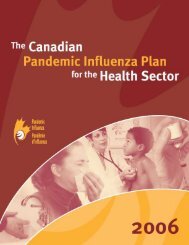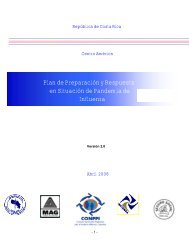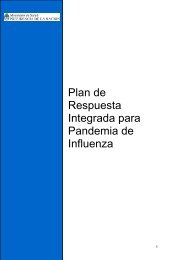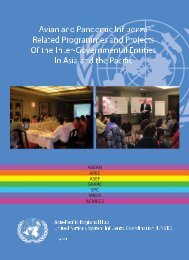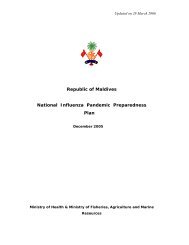Tanzania National Plan (January 2007)[1].pdf - Avian Influenza and ...
Tanzania National Plan (January 2007)[1].pdf - Avian Influenza and ...
Tanzania National Plan (January 2007)[1].pdf - Avian Influenza and ...
You also want an ePaper? Increase the reach of your titles
YUMPU automatically turns print PDFs into web optimized ePapers that Google loves.
<strong>Tanzania</strong> <strong>Avian</strong> <strong>Influenza</strong> <strong>National</strong> Emergency Preparedness & Response <strong>Plan</strong><br />
In broilers, the signs of disease are frequently less obvious with severe depression, in<br />
appetence, <strong>and</strong> a marked increase in mortality being the first abnormalities observed.<br />
Swelling of the face <strong>and</strong> neck <strong>and</strong> neurological signs such as torticollis <strong>and</strong> ataxia may<br />
also be seen.<br />
The disease in turkeys is similar to that seen in layers, but it lasts 2 or 3 days longer<br />
<strong>and</strong> is occasionally accompanied by swollen sinuses. In domestic ducks <strong>and</strong> geese<br />
the signs of depression, in appetence, <strong>and</strong> diarrhea are similar to those in layers,<br />
though frequently with swollen sinuses. Younger birds may exhibit neurological signs.<br />
Birds that die of peracute disease may show minimal gross lesions, consisting of<br />
dehydration <strong>and</strong> congestion of viscera <strong>and</strong> muscles.<br />
In birds that die after a prolonged clinical course, petechial <strong>and</strong> ecchymotic<br />
haemorrhages occur throughout the body, particularly in the larynx, trachea,<br />
proventriculus <strong>and</strong> epicardial fat, <strong>and</strong> on serosal surfaces adjacent to the sternum.<br />
There is extensive subcutaneous oedema, particularly around the head <strong>and</strong> hocks.<br />
The carcass may be dehydrated. Yellow or grey necrotic foci may be present in the<br />
spleen, liver, kidneys <strong>and</strong> lungs. The air sac may contain exudates. The spleen may<br />
be enlarged <strong>and</strong> haemorrhagic.<br />
2.5. <strong>Avian</strong> influenza in humans<br />
The first case H5N1 virus to of spread from a bird to a human was seen during an<br />
outbreak of bird flu in poultry in Hong Kong, Special Administrative Region in 1997.<br />
The virus caused severe respiratory illness in 18 people, 6 of whom died. Since that<br />
time, there have been other cases of H5N1 infection among humans. Recent human<br />
cases of H5N1 infection that have occurred in Cambodia, Thail<strong>and</strong>, <strong>and</strong> Vietnam have<br />
coincided with large H5N1 outbreaks in poultry. The World Health Organization<br />
(WHO) also has reported human cases in Indonesia. Most of these cases have<br />
occurred from contact with infected poultry or contaminated surfaces. However, the<br />
spread of avian influenza viruses from one ill person to another has been reported<br />
very rarely, <strong>and</strong> transmission has not been observed to continue beyond one person.<br />
Symptoms of bird flu in humans although not pathognomonic have ranged from typical<br />
flu-like symptoms (fever, cough, sore throat <strong>and</strong> muscle aches) to eye infections,<br />
pneumonia, severe respiratory diseases (such as acute respiratory distress), <strong>and</strong><br />
other severe <strong>and</strong> life-threatening complications. The symptoms of bird flu may depend<br />
on which virus caused the infection.<br />
Treatments for H5N1 influenza has been attempted using oseltamavir <strong>and</strong> zanamavir.<br />
H5N1 infections have been found to be resistant to two other antiviral medications<br />
namely amantadine <strong>and</strong> rimantadine that are commonly used for influenza treatment.<br />
There is currently no commercially available vaccine to protect humans against the<br />
H5N1 virus that is being seen in Asia <strong>and</strong> Europe. However, vaccine development<br />
efforts are taking place. Research studies to test a vaccine to protect humans against<br />
H5N1 virus are continuing.<br />
14


![Tanzania National Plan (January 2007)[1].pdf - Avian Influenza and ...](https://img.yumpu.com/36423433/14/500x640/tanzania-national-plan-january-20071pdf-avian-influenza-and-.jpg)



